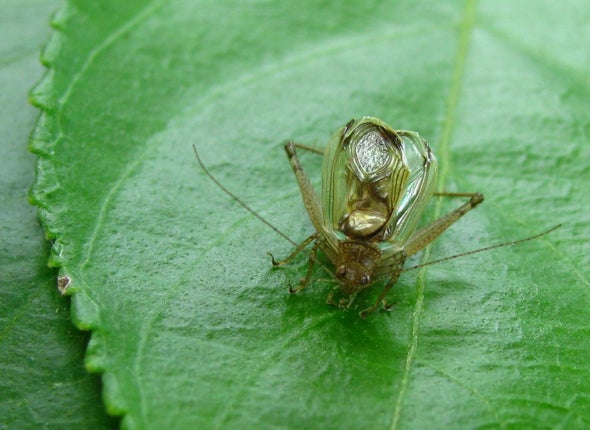(单词翻译:单击)
听力文本
This is Scientific American's 60-second Science, I'm Emily Schwing.
(CLIP: Sounds of the Panamanian rain forest)
"So what you're listening to now, that's a recording from the rain forest."
That's Marc Holderied of the University of Bristol in the U.K. He specializes in bioacoustics: how animals produce sound and communicate with the sounds they make. In the recording you just listened to, Holderied removed the sounds we humans can hear and reduced the frequencies of the sounds we normally wouldn't hear so that they're audible to our ears.
"A rain forest is a very noisy environment. There's insect sounds, bird sounds; there's leaves rustling. And all of this makes it harder for you to detect something you want to hear."
Holderied is particularly interested in sounds from the ultrasonic range—these are frequencies our ears can't detect. But they come in loud and clear for a sword-tailed cricket in Panama. Here's their home, slowed down so we can hear it.
(CLIP: Forest sounds)
Holderied and colleagues at the Universities of Bristol and Graz in Austria, recently discovered the sword-tailed cricket has a novel survival strategy when it comes to life in their noisy environment.
"Up there, it's mainly other insects that produce noises that stop you from detecting what you really want to detect—and that is a predator that might attack you."

Every night, hundreds of species of hungry bats fly around the rain forest and use echolocation to hunt for their meals, which can include the cricket.
"So we are talking neotropical rain forests, and they teem with different bat species. And most of them, or many of them, would be after insects. So the frequencies that they use to find the insect prey are covering pretty much a full echolocation-frequency range."
Echolocation is great for hunting. But Holderied says it's also a potential weakness for bats—because in the ultrasonic world, these calls are very, very loud.
"And once you have cracked that, once you have evolved an ear that lets you hear these calls, you can simply fly away and escape into safety...."
Which the cricket has learned to do.
"Basically, they have a response threshold–that's what we call it. So they only respond to sounds that are very loud."
And how do they respond? Well, they simply stop flying—and plummet toward the ground.
"Sometimes they don't even drop all the way to the ground. So if the calls are louder, they stop flying for a longer period of time–that means a longer drop. But if they stop for just a half a second, that might not be enough time for them to hit the ground. And after this half a second, they start flying again, but they're never actually crashing. But they drop out of the bat's approach vector."
The study of the crickets' novel survival strategy is in the journal Philosophical Transactions of the Royal Society B.
"It's a beautiful example of this predator-prey arms race."
In this case, the passive prey has found a way to live, and listen for, another day.
Thanks for listening for Scientific American's 60-second Science. I'm Emily Schwing.
参考译文
这里是科学美国人——60秒科学系列,我是埃米莉·施温。
(音频片段:巴拿马雨林的声音)
“现在你听到的是来自雨林的录音。”
英国布里斯托大学的马克·霍尔德里德说到。他专门研究生物声学:动物如何发出声音并利用声音交流。在刚才听到的录音中,霍尔德里德删除了人类能听到的声音,并降低了我们通常听不到的声音的频率,以便我们能听到这些声音。
“雨林是非常嘈杂的环境。有昆虫叫声,鸟鸣声和树叶沙沙作响的声音。所有这些都使我们更难发现我们想听到的声音。”
霍尔德里德对超声波范围的声音特别感兴趣,而这些频率我们的耳朵无法探测到。但对巴拿马剑尾蟋蟀来说,这些声音会响亮且清晰地出现。这是它们的栖息地,声音频率被降低,因此我们能听到。
(音频片段:雨林的声音)
霍尔德里德和他在奥地利布里斯托尔大学以及格拉兹大学的同事最近发现,剑尾蟋蟀在喧闹的环境中生活时,有一种新颖的生存策略。
“在那里,主要是产生噪音的其他昆虫产生噪音会阻止你探听到你真正想要听到的东西——那是可能攻击你的捕食者。”
每天晚上,数百种饥饿的蝙蝠在雨林中飞来飞去,利用回声定位来觅食,它们的猎物可能包括蟋蟀。
“我们谈论的是新热带区雨林,那里到处都是各种种类的蝙蝠。其中大多数蝙蝠,或者说许多蝙蝠,都会追逐昆虫。因此,它们用来发现昆虫猎物的频率几乎覆盖了回声定位的整个频率范围。”
回声定位在狩猎中非常有用。但是霍尔德里德表示,这也是蝙蝠的潜在弱点,因为在超声世界,这些叫声非常非常响。
“一旦你破解了它,一旦你进化出能让你听到这些叫声的耳朵,你就能飞离,逃到安全地带。”
蟋蟀已经学会这样做了。
“基本上,它们拥有我们所说的反应阈值。因此它们只对非常响的声音有反应。”
它们如何反应?它们只是停止飞行,然后突然降至地面。
“有时它们甚至不会一直落到地面。如果声音比较响,它们会长时间停止飞行,这意味着长时间的停滞。但是如果它们只停下半秒种,那没有足够的时间让它们落到地面。半秒钟之后,它们会再次起飞,这不是真正的坠落,只是逃脱蝙蝠的追捕。”
蟋蟀新奇生存策略的相关研究发表在《英国皇家学会哲学学报B》期刊上。
“这是捕食者与猎物之间军备竞赛的漂亮例子。”
在这个例子中,被动的猎物找到了一种生活方式,可以再活一天并再听一天。
谢谢大家收听科学美国人——60秒科学。我是埃米莉·施温。
译文为可可英语翻译,未经授权请勿转载!
重点讲解
重点讲解:
1. specialize in 专门从事;专门经营;专门研究;专攻;
He specialized in treatment of cancer patients.
他是治疗癌症病人的专家。
2. slow down (使)放慢;
The body's metabolism is slowed down by extreme cold.
严寒可以使身体新陈代谢的速度下降。
3. teem with 充满,充斥(人或动物);
For most of the year, the area is teeming with tourists.
一年中大部分时间里,这个地区游人如织。
4. respond to 应对;作出回应;作出反应;
The animals were conditioned to respond to auditory stimuli.
经过训练,那些动物对声音形成了条件反射。


